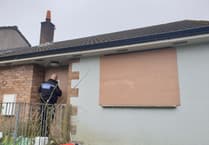AS the cold and icy winter weather settles in, you may have noticed that your boiler has stopped working; one very common cause could be that your condensate pipe has frozen.
The condensate pipe leads waste water away from the boiler and down a drain.
Most are fitted internally but, in some cases, they have to be fitted outside, which can cause the pipe to freeze.
Education experts at skillstg.co.uk outline the best way to thaw a condensate pipe and how to prevent it from freezing in the first place so that you can stay warm and cosy this winter.
How to thaw your condensate pipe Step one
Find your condensate pipe. A white pipe should protrude from the wall portion located directly behind your boiler. You’ll know you have the right pipe if it runs right out from the boiler to an exterior drain.
Step two
Boil your kettle and let the water cool for approximately 15 minutes – you want the water to be warm rather than boiling hot.
Starting at the top of the kettle and making your way down the pipe, pour the warm water over your frozen condensate pipe until the ice blocking it has thawed.
Step three
Reset your boiler. Wait a few minutes and check that it is working properly. If you have fully thawed your frozen condensate pipe, everything should be working as normal.
How to prevent a frozen condensate pipe
Now that you have thawed your frozen condensate pipe, you will want to ensure that it doesn’t happen again. To do that, you’re going to want to follow our preventative tips:
Install a large pipe
The best way to lower your chances of dealing with another frozen condensate pipe is to install a pipe that is as large as possible.
Before doing this, you should take a look at the manufacturer’s instructions to see what they recommend.
Usually, manufacturers will recommend pipes in the range of 32-40mm, but it is possible to have an engineer install a thicker pipe if you have to deal with extremely cool temperatures, where thinner pipes might not cut it.
Add insulation
Insulating your condensate pipe will help to protect it from the elements. It’ll be kept warmer, which means that it will be far less likely to end up frozen.
In order to insulate your boiler condensate pipe, simply wrap it with foam pipe insulation and secure it with strong tape or cable ties.
Reduce external piping
It stands to reason that the less condensate pipe you have outside your home, the less opportunity there is for your pipes to freeze over.
So, if it is possible for you to do so, you might want to move the pipes to minimise exposure to the elements. Usually, you will need to call a heating engineer to help you with this.
Reduce exposure
Placing your condensate pipe in the optimum position so that it gets plenty of sun and isn’t particularly exposed to the elements is a good way to minimise the risk of freezing.
Gravity
Ensuring that waste falls from your pipe as quickly and from as great a height as possible will help to keep the pipe clear so that it is unlikely to become blocked.
Ensuring that your pipes have as few bends as possible will also help to this end.
Get a siphon trap
If you’re in the process of purchasing a new boiler, try to choose one that features a siphon trap.
This type of condensate release flushes out the water in one go, thus lowering the risk of freezing.
Most boilers release the water in long drawn-out drips, meaning more water is present for longer, making it more likely that a freeze will occur.
Trace
A trace is an electrical element that can be bonded to the area below your condensate pipe. It can warm the pipe when the temperature drops below 5°C. If you install it, you must also add lagging to the pipe to ensure that it is insulated.
If you live in an area where temperatures regularly drop below 0°C for a prolonged period of time, this could be a useful addition to your boiler set-up because it really is the only way that you can guarantee your pipe will not freeze.
It should be noted that the only way to add a trace to your boiler condensate pipe is by calling




